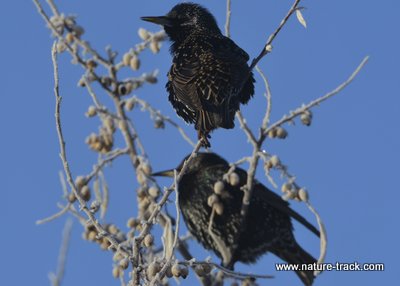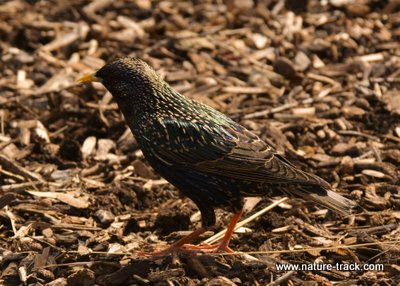Starling Wars

Winter starling above, starling in springtime dress below.

Starlings are handsome birds but that doesn’t excuse their bad behavior.
I am at war. I have procured arms and devised strategies to defeat my enemy. So far though, skirmishes have been few and decidedly not in my favor. My enemy is effectively using the tactics of hit and run guerilla warfare.
My enemy is the ubiquitous European starling which may be the darling of that continent but is a scourge on this one. As the name indicates, starlings come from Europe and were intentionally introduced to this country, but didn’t bring their native population constraints with them.
The crime that the starlings commit that forces me to adopt drastic and lethal methods is one I mentioned several weeks ago regarding my homemade suet blocks. Starlings discovered them and now 15-20 at a time will invade my yard and make quick work of the suet to the dismay of chickadees, woodpeckers and house finches.
At that time, magpies were also a dilemma and reader Bob Cherry sent me his solution to keeping magpies at bay without having to resort to lethal force. You can read about Bob’s magpie solution and see his photos on my blog at: https://www.nature-track.com/nature-blog.html.
However, Bob’s elegant solution doesn’t work for the highly intelligent starling, especially given the fact that they are about the same size as the other birds I do want to attract. I have found no other solution other than to declare war with no prisoners.
Even while I plot their demise, I have to admit to a grudging respect for the starling. First, they are quite handsome birds. Often described as short-tailed and chunky, this time of year they are almost all black with white spots sprinkled across their bodies. But their springtime wardrobe shines with an iridescent purple-green sheen. Their bill turns bright yellow as well, contrasting against the glossy black feathers. They are handsome birds.
I also admire their pluck. About 100 birds were released in New York City in 1890 by homesick European immigrants. Fifty years later they were in California and now occupy habitat from Alaska, the southern half of Canada and all of the lower 48 states.
There’s a lot not to like about starlings as well. These highly adaptable birds not only have taken to our continent and habitat, particularly nesting cavities and nest boxes, meant for native birds, they are also intolerant of other species. They routinely kill nestlings and destroy eggs of other birds and even kill adults that are sitting on eggs. Starlings, as demonstrated on my suet feeder, large flocks can dominate a food source keeping other birds away. They also do significant crop damage, foul livestock forage and generally earn their scientific name of Sturgis vulgaris.
I am a pragmatist, not a wanton backyard wildlife killer. If there were a different way, I would take it. I tolerate house sparrows, another invasive species, so long as they behave. I encourage most other wildlife and most recently can count both white-tailed and black-tailed jackrabbits as newcomers to my suburban backyard along with an ever present cottontail rabbit and even the exotic fox squirrels.
Because of their bully nature though, starlings have always been on thin ice and this time they have gone too far. If it’s war they want, it’s war they’ll get. I harbor no illusions of winning though.

Wildlife License Plates
Great news! as of 2024, there are three NEW designs for license plates. They still are bluebird, cutthroat trout and elk, but they are beautiful.
Idaho Wildlife license plates provide essential funding that benefits the great diversity of native plants and wildlife that are not hunted, fished or trapped—over 10,000 species or 98% of Idaho’s species diversity. Game species that share the same habitats (such as elk, deer, antelope, sage-grouse, salmon, trout) also benefit from these specialty plates.
No state tax dollars are provided for wildlife diversity, conservation education and recreation programs. Neither are any revenues from the sale of hunting or fishing licenses spent on nongame species. Instead, these species depend on direct donations, federal grants, fundraising initiatives—and the Idaho Wildlife license plates.
Both my vehicles have Bluebird Plates. I prefer the bluebird because the nongame program gets 70 percent of the money from bluebird plates, but only 60 percent of the money from elk and trout plates - 10 percent of the money from elk plates supports wildlife disease monitoring and testing programs (to benefit the livestock industry) and 10 percent from cutthroat plates supports non-motorized boat access.
Incidentally, in 2014, the Idaho Legislature denied the Department of Fish and Game the ability to add new plates or even to change the name of the elk and cutthroat plates (very specific) to wildlife and fish plates, a move that would have allowed for changing images occasionally and generating more revenue. It would seem that they believe that we Idahoans don't want a well funded wildlife program.
I think it is time we let the Legislature know that Idahoan support wildlife funding and that we would like to see these generic plates come to fruition.
Wildlife License Plates
Great news! as of 2024, there are three NEW designs for license plates. They still are bluebird, cutthroat trout and elk, but they are beautiful.
Idaho Wildlife license plates provide essential funding that benefits the great diversity of native plants and wildlife that are not hunted, fished or trapped—over 10,000 species or 98% of Idaho’s species diversity. Game species that share the same habitats (such as elk, deer, antelope, sage-grouse, salmon, trout) also benefit from these specialty plates.
No state tax dollars are provided for wildlife diversity, conservation education and recreation programs. Neither are any revenues from the sale of hunting or fishing licenses spent on nongame species. Instead, these species depend on direct donations, federal grants, fundraising initiatives—and the Idaho Wildlife license plates.
Both my vehicles have Bluebird Plates. I prefer the bluebird because the nongame program gets 70 percent of the money from bluebird plates, but only 60 percent of the money from elk and trout plates - 10 percent of the money from elk plates supports wildlife disease monitoring and testing programs (to benefit the livestock industry) and 10 percent from cutthroat plates supports non-motorized boat access.
Incidentally, in 2014, the Idaho Legislature denied the Department of Fish and Game the ability to add new plates or even to change the name of the elk and cutthroat plates (very specific) to wildlife and fish plates, a move that would have allowed for changing images occasionally and generating more revenue. It would seem that they believe that we Idahoans don't want a well funded wildlife program.
I think it is time we let the Legislature know that Idahoan support wildlife funding and that we would like to see these generic plates come to fruition.

"WOW. What a phenomenal piece you wrote. You are amazing." Jennifer Jackson
That is embarrassing, but actually a fairly typical response to my nature essays. Since The Best of Nature is created from the very best of 16 years of these nature essays published weekly in the Idaho Falls Post Register (online readership 70,000), it is a fine read. It covers a wide variety of topics including humorous glimpses of nature, philosophy, natural history, and conservation. Readers praise the style, breadth of subject matter and my ability to communicate complex and emotional topics in a relaxed and understandable manner.
Everyone can find something to love in this book. From teenagers to octogenarians, from the coffee shop to the school room, these nature essays are widely read and enjoyed.
Some of the essays here are my personal favorites, others seemed to strike a chord with readers. Most have an important message or lesson that will resonate with you. They are written with a goal to simultaneously entertain and educate about the wonderful workings of nature. Some will make you laugh out loud and others will bring a tear to the eye and warm your heart.
Readers Write:
"You hit a home run with your article on, Big Questions in Nature. It should be required reading for everyone who has lost touch with nature...great job!" Joe Chapman
"We enjoyed your column, Bloom Where Planted. Some of the best writing yet. The Post Register is fortunate to have your weekly columns." Lou Griffin.
To read more and to order a copy, click here or get the Kindle version
Copies are also available at:
Post Register
Island Park Builders Supply (upstairs)
Barnes and Noble in Idaho Falls
Harriman State Park, Island Park
Museum of Idaho
Valley Books, Jackson Wyoming
Avocet Corner Bookstore, Bear River National Wildlife Refuge, Brigham City, Utah
Craters of the Moon National Monument Bookstore, Arco, Idaho